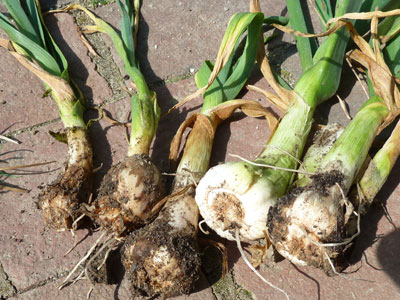 |
| Garlic affected by bloat nematodes may be missing roots, and the basal plate may appear to have a dry rot. Sideman photo. |
By Eric Sideman, Ph.D.
The stem and bulb nematode, or bloat nematode as it is often called, is not a new pest. It was reported in New York and California in the ‘30s. But recently it has popped up in new places and in larger numbers. This year it has reached levels that are catching the eyes of garlic producers all over our region.
In 2010 the nematode caused major crop loss in sections of fields in garlic producing regions of New York and in Ontario, Canada. Now it is being confirmed as the culprit in major losses to garlic producers in New England, including Maine.
Since planting infected seed is the most common way of spreading this problem, fall is a good time to learn about the pest and assess your risk. The message is this: Do not plant a problem, and if you are a garlic seed producer, do not sell a problem.
This nematode is nearly microscopic. You cannot tell if the seed is infected without sending it to a lab. If you are using your own seed and have done so for a decade, then you probably don’t have the problem, but if you have bought seed in the past three or four years, there is a risk – even if you bought only a small amount. The problem may start with a bit of purchased garlic seed, and initially only those few plants may be infected, but the nematode can then spread in your field and contaminate all your seed. This can happen to anybody, so if you are buying seed, you are depending on the seed seller to be vigilant and scrupulous.
Watch during the growing season for symptoms, which are fairly obvious in growing garlic. If suspect symptoms arise, get the material diagnosed in a laboratory. Some other garlic problems, such as bulb mites or Fusarium, cause similar symptoms. Learn the symptoms, be on the outlook and work with the experts at your state university labs. If you suspect your seed, get it looked at by a lab before you plant.
Symptoms
Severely infected garlic plants are yellow and stunted, and the leaves may collapse prematurely. If you have plants with these symptoms, pull one up. The roots are often missing in severely infected plants, and the basal plate may appear to have a dry rot similar to Fusarium basal plate rot. Sometimes only one side or a small portion of the roots are missing. Other hosts, such as onions, show a distinct bloating and twisting of the leaves and stem.
The bloat nematode has no problem surviving the winter, or very dry conditions. Typically it passes the winter in the garlic bulb, but it can also survive in crop debris or free in the soil.
There are male and female nematodes; they reproduce by mating. The life cycle takes as little as 20 days. The larvae go through stages, and the fourth stage is the infective stage.
These roundworms can move in a film of water and penetrate young leaf, stem, bulb and root tissue. The nematode moves out of the plant tissue only when the tissue begins to decompose. It cannot move far on its own, but is spread with soil, crop debris, water, equipment, and mostly by garlic seed.
By mid-July 2012, I knew of more than a dozen Maine farms and gardens with the problem, but I was regularly hearing of more and the problem is likely much more widespread. A study in New York in 2010 found it in 28 of 100 samples from 16 counties across the state. We all have to work to keep this pest from becoming a major destructive force in local garlic production.
Management
Here are some management tips. A new fact sheet on the bloat nematode by Steve Johnson and Dave Fuller, posted on the University of Maine Cooperative Extension website (https://extension.umaine.edu/), has more detail and information about sending samples to the lab for diagnosis.
1. Plant clean seed. Contaminated seed is the most common way the nematode is introduced to new fields. Buy from a reputable source, or be certain you are not harboring the pest.
2. Rotate crops. A four-year rotation is recommended for garlic production. Rotate out of all species of Allium (garlic, onion, leek, chives) and other known host crops, including celery, parsley and ‘Shasta’ pea. Control weed hosts, including hairy nightshade and Canada thistle. Known non-host plants are carrots, potatoes, spinach and corn.
3. Rotate with specific cover crops. Several mustard cover crops (mustard, rapeseed, oilseed radish) as well as sorghum-sudangrass reduce the soil population of parasitic nematodes by producing toxic metabolites as they decompose. Grow the cover crop until it just begins to bud and then incorporate it into the soil.
4. Treat garlic seed with hot water. This practice has ruined a lot of garlic seed, because it is too easy to do it a bit too long or too hot. I would not recommend hot water treatment unless you have had training and you have no other options except using infected material. Also, it has not proven to be 100 percent effective. For details, see www.hort.cornell.edu/expo/proceedings/Onions-&-Garlic/Abawi-bloatSum.pdf
Most important, monitor your garlic planting, identify any problems, and then learn how to manage them.
Eric Sideman is MOFGA’s organic crop specialist. You can contact him with your questions at [email protected] or 568-4142.

